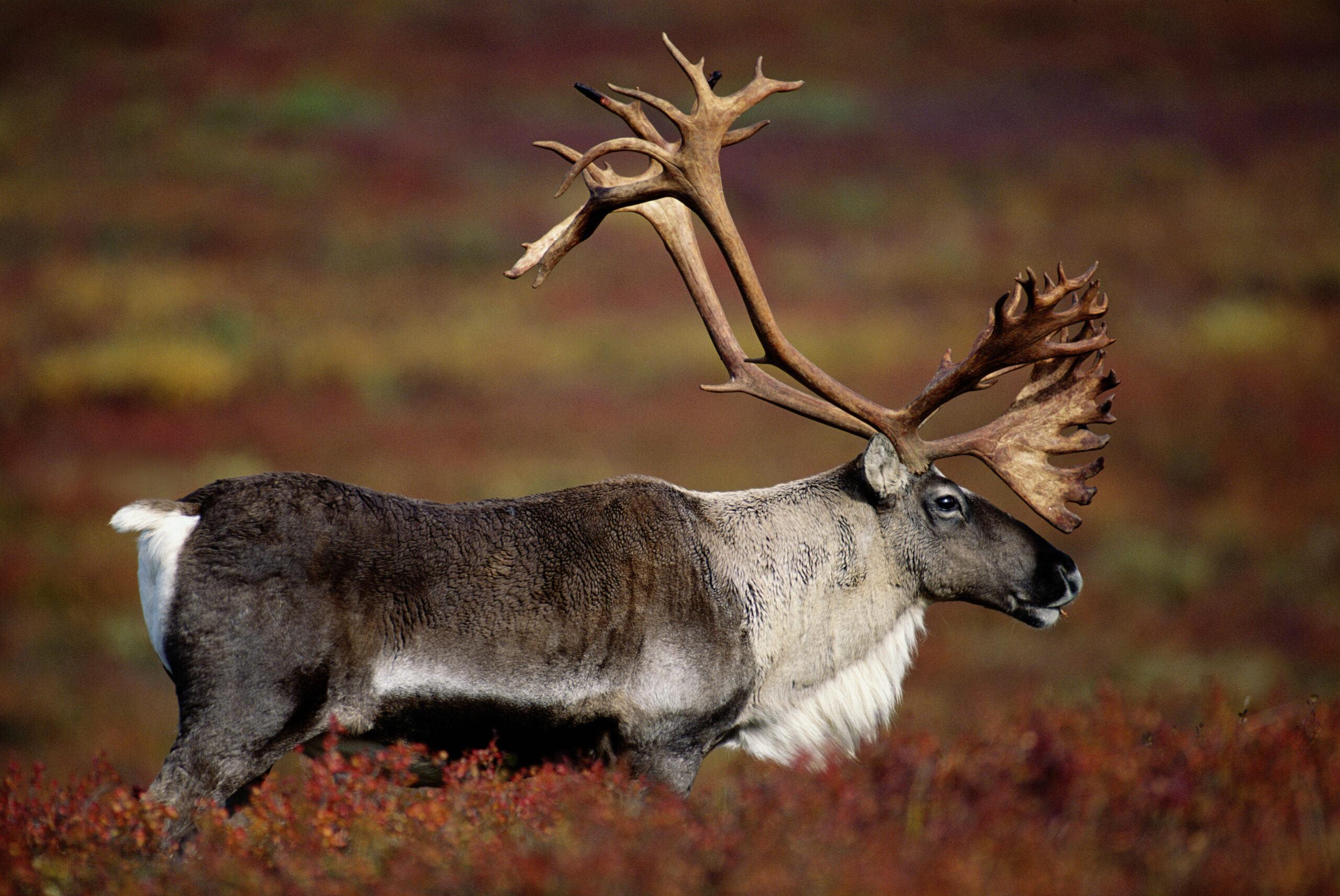This story first appeared in the March 1959 issue. Charlie Elliott was a legendary writer and editor for Outdoor Life. He retired as the Southern field editor in 1972, but continued to freelance for the magazine.
I HAD ALWAYS considered “bone weary” as two mismatched words that some one carelessly tossed together. Now I knew better. I was tired all the way to my marrow.
Climbing this almost-vertical canyon was about like trying to go up a 1,000-foot ladder on slippery, broken rungs. I could still lift my heavy feet, but putting them down solidly was another matter. The rocks were either loose sharp enough to jab holes through my boots, or slick as greased rawhide.
Somewhere on the hill to my right, beyond the canyon wall, a big bull caribou grazed unsuspectingly. Maybe he’d keep his nose buried in the reindeer moss until I could stalk near enough to deliver a lethal dose of lead.
Twice in the past half hour, I’d scaled this canyon wall to see if he was still there. After each climb, I dangled myself inch by inch back to the canyon floor, to continue the hazardous stalk.
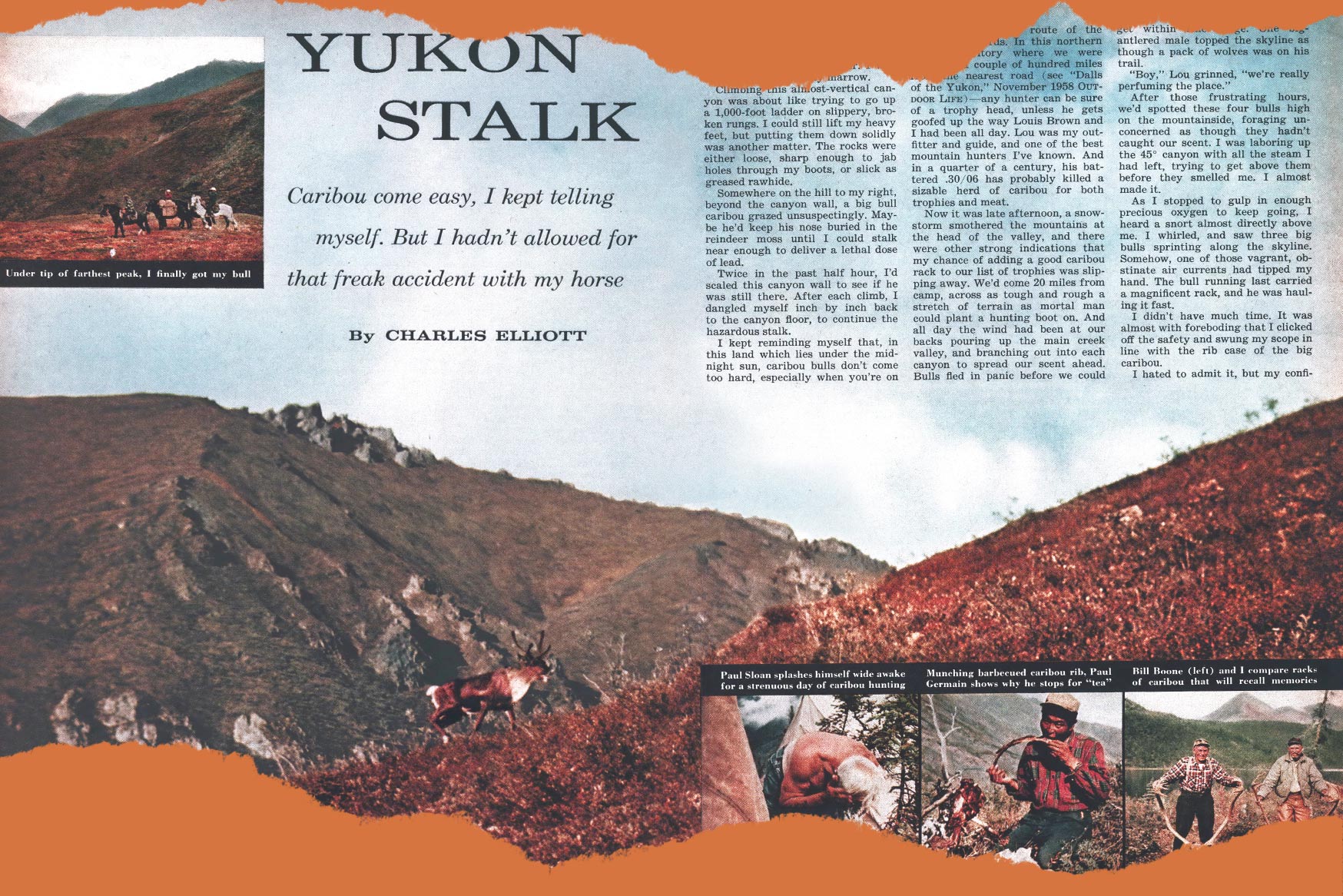
I kept reminding myself that, in this land which lies under the midnight sun, caribou bulls don’t come too hard, especially when you’re on the main migration route of the tremendous herds. In this northern Yukon Territory where we were hunting—a couple of hundred miles from the nearest road (see the first story in this series, “A Classic Dall Sheep Hunt”)—any hunter can be sure of a trophy head, unless he gets goofed up the way Louis Brown and I had been all day. Lou was my outfitter and guide, and one of the best mountain hunters I’ve known. And in a quarter of a century, his battered 30/06 has probably killed a sizable herd of caribou for both trophies and meat.
Now it was late afternoon, a snowstorm smothered the mountains at the head of the valley, and there were other strong indications that my chance of adding a good caribou rack to our list of trophies was slipping away. We’d come 20 miles from camp, across as tough and rough a stretch of terrain as mortal man could plant a hunting boot on. And all day the wind had been at our backs pouring up the main creek valley, and branching out into each canyon to spread our scent ahead. Bulls fled in panic before we could get within rifle range. One big-antlered male topped the skyline as though a pack of wolves was on his trail.
“Boy,” Lou grinned, “we’re really perfuming the place.”
After those frustrating hours, we’d spotted these four-bulls high on the mountainside, foraging unconcerned as though they hadn’t caught our scent. I was laboring up the 45-degree canyon with all the steam I had left, trying to get above them before they smelled me. I almost made it.
As I stopped to gulp in enough precious oxygen to keep going, I heard a snort almost directly above me. I whirled, and saw three big bulls sprinting along the skyline. Somehow, one of those vagrant, obstinate air currents had tipped my hand. The bull running last carried a magnificent rack, and he was hauling it fast.
I didn’t have much time. It was almost with foreboding that I clicked off the safety and swung my scope in line with the rib case of the big caribou.
I hated to admit it, but my confidence was shaking like a fit of the ague. I’d missed one bull already that day.
FOUR OR FIVE miles down the valley, we’d spotted a herd with two good heads in it. When we glassed them from a mile away, they had our wind and stood with their heads up, working the air for the strange scent. Normally, a migrating herd isn’t too concerned at the sight of horses, but that bunch hadn’t got the word. Though we rode toward them slowly, they seemed to suspect that we had lethal intentions. As we approached, they turned back up the valley, pausing to look over their shoulders. Lou wagged his head in exasperation.
“Things have come to a pretty pass,” he muttered, “when you can’t get close enough to kill a cow-boo.”
They were retreating up around a hillside contour, so Lou swung his horse down toward the creek.
“If they think we’re going around them,” Lou explained, “they might stand until we get directly below and close enough for a shot.”
But the herd outguessed us and trotted along the slope. About 600 yards away, they turned downhill.
We changed direction again, heading up the steep mountainside as though we intended to bypass the animals high up. But they refused to be duped; they crossed the stream and climbed the slope beyond, still going away.
“That bunch is crazy,” Lou said.
But it was the sort of craziness that kept them out of rifle range. Back in the creek bottom for our third try, Lou put his horse into a fast trot over a rocky caribou trail. I bounced along behind, hoping my horse wouldn’t stumble and pile us both into the jumble of boulders. The caribou were so curious about this sudden burst of speed that they finally stopped to watch, and we pulled even with them about 250 yards away.
“Looks to me,” said the guide, “like this is as close as we’ll get.”
I slid out of the saddle, unsheathing my .300 Kennon Magnum. Shooting from that point would be simple—or so I thought. One of the two bulls carried a tall, graceful rack with a broad snow shovel. It was as large a trophy as we’d seen on the trip. He stood broadside and gave me plenty of time to sit with my back against a rock and take careful aim. I squeezed off a shot, and the bull didn’t even quiver. I glanced at Lou sheepishly.
“Where’d it hit?”
“Couldn’t tell,” he replied. “The slope’s too rocky.”
Taking my time, I held as steady as if I were sighting at a bullseye back on the home range. At the second blast, the herd broke into a trot. Foolishly, I flung a couple of desperation shots which did no damage. Lou was watching me and at that moment I felt so small that he could have hidden me in corner of a saddle pocket.
“One rifle for sale cheap,” I tried to quip.
“Must be those sights,” he stated. “You’ve been saying something about them.”
I know my face must be burning, because I was as guilty as the most inexperienced tyro. I tried to think of an excuse for taking a chance on something that might have cost me much more than a trophy. I couldn’t. Lou grinned as I berated myself with some choice words.
“Better see how’s she shooting,” he said. “We might meet up with a grizzly and I’m too tired to run.”
THAT MISSED CARIBOU actually was the result of a freak accident that had happened a couple of days before. Guide Paul Germain and I were struggling through a canyon that was so rough we had to get off and lead our horses. Paul led the way, zigzagging along to find places where we and the horses could walk without sliding off the bluff.
My guide was taking the rough, alder-choked canyons in stride until we came to one where I had to swing on the branches to stay on my feet. His mount, by a display of sheer strength, lunged into the rocky canyon and out the other side. When he was safely out of the way I followed, leading Pat, my horse.
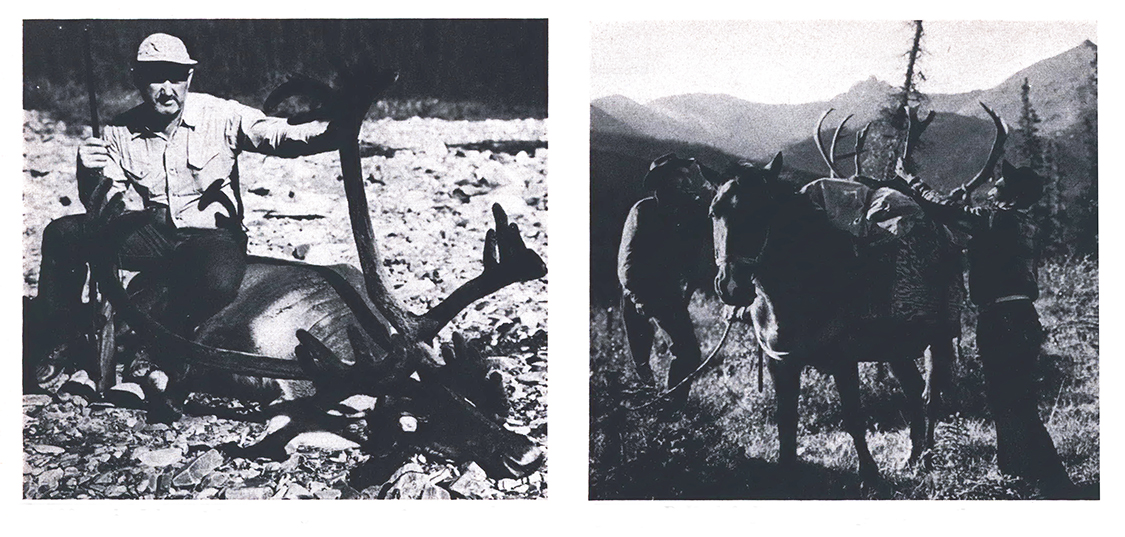
I scrambled up the far rim, but my horse didn’t make it. His hind feet slipped off a moss-coated boulder, and he lunged forward, trying to catch himself on his front feet. No go. I tried to hold my horse’s head up, but he went end over end, slapping me against a spruce tree as he skidded into the canyon, finally piling up against a mass of rocks that kept him from going all the way to the creek.
My guide came back on the run. Pat was on his back, his head downhill. His hind feet were tangled in a willow clump, and his position was so awkward that he couldn’t jerk free. Ignoring a possible kick in the stomach, Paul and I tugged his feet loose. He half rolled, stumbled upright, and stood trembling, while we examined him for broken bones.
Then I looked at my rifle, Pat had rolled over it twice, and had knocked my detachable scope completely off in the saddle scabbard. But both scope and mounts were sturdy, and looked O.K. I clicked the scope back into place.
“Glad I wasn’t in that saddle,” I said.
“Might have torn your shirt,” he commented wryly.
WE WERE IN country full of grizzly and caribou sign, and I didn’t want to spook the game by shooting to sight in my rifle again. When we reached less-rugged terrain above the canyon, however, I bore-sighted the gun, and it seemed to be in alignment with the scope’s crosshairs.
We returned to camp late that night, and moved the outfit to a new site the next day. Somehow I just didn’t get around to checking the rifle with live ammunition. Now I paid for that oversight by missing the easy shot at a good bull caribou.
“Before we go any farther,” Lou suggested, “let’s see how much that thing is off.”
I hung my paper lunch sack on a bush, stepped off 300 feet, and took a rough bench rest over a big boulder. At 100 yards, my chunk of lead hit eight inches low. I adjusted the scope until I was shooting an inch high at the same distance. I was so disgusted with myself that I’d have quit hunting, but Lou wouldn’t listen.
“We haven’t got but another day or two to find a good head,” he said, “and we’d better burn as much daylight as we can.”
In this vast, wild region of Canada’s upper Yukon Territory, the hunting area assigned to Lou Brown by the game director covers roughly 12,000 square miles along the Wind and Bonnet Plume Rivers. These flow northward into the Mackenzie River and on to the Beaufort Sea, an arm of the Arctic Ocean. No one except Louis and his parties is allowed to hunt those bleak slopes on the arctic side of the Mackenzie Mountains, which separate the Yukon and Mackenzie watersheds.
For the first three weeks of August, before the snow started flying around the mountaintops, we’d spent all our daylight hours on sheep and moose, waiting for the annual caribou migration.
This migration is one of the impressive spectacles of nature. No one could give me even a rough estimate of the size of the Yukon herd. The Alaska herd, which spills over into the northwestern section of Yukon Territory, is followed by planes, dog teams, and a corps of biologists. But the Yukon herd is more or less an unknown quantity. The guesses run from tens to hundreds of thousands of animals.
Lou Brown told me that they summer out on the bleak flats which slope off toward the rim of the Arctic Ocean. On that vast expanse of treeless tundra, the ice doesn’t break up until middle or late June. Calves are born there, and grow into the gangling stage. Then, when the first August frosts begin to nip at their heels, the herd moves southward—first by twos and threes and dozens, then in a mass that sweeps through the tremendous valleys and over the high ridges in white-rumped waves. The caribou follow the creeks and swim the icy rivers; they climb through the mountain ranges separating the two mighty watersheds. Finally they winter in the forests and valleys at the headwaters of the Yukon River and its tributaries.
Among biologists and mountain men, there’s much discussion about caribou species. The books claim more than a dozen species and subspecies. Some younger experts say they’re all practically the same animal, and merely live in different places. A few old heads at guiding and outfitting in the Yukon declare that this is the true Osborne caribou; others state that the migrating mass is made up of Barren Ground reindeer, American variety, and that there’s a difference between this animal and the mountain branch of the family that lives farther south.
Whatever their family tree, these animals gave our hunt in north Yukon an arctic flavor. We encountered a great many of them after the middle of August, and my tent mates John Harness, Bill Boone, and Paul Sloan—top sportsmen who are business men and ranchers from California—told me of herds they saw numbering in the hundreds when they hunted this same country a month later in the season, some years back.
We found the vanguards of the migrating masses more cagey than I’d anticipated. We jumped our first bull out of the wide Bourbon Creek canyon, and peeled off our horses to look him over. His rack was in velvet, but its spread was sizable and John Harness decided to take him. John squatted, watching the bull trot out across a gravel bar.
“Don’t shoot him in the hams,” I begged.
John grunted, considering my suggestion an insult. He’s been a member of California’s rifle team fifteen times at the national rifle matches. The bull swung broadside; when John’s .300 Weatherby Magnum barked, the animal sank to its belly with its feet under it. At more than 100 yards, John had shot out one eye, and his bullet had gone on through, just missing the other eye.
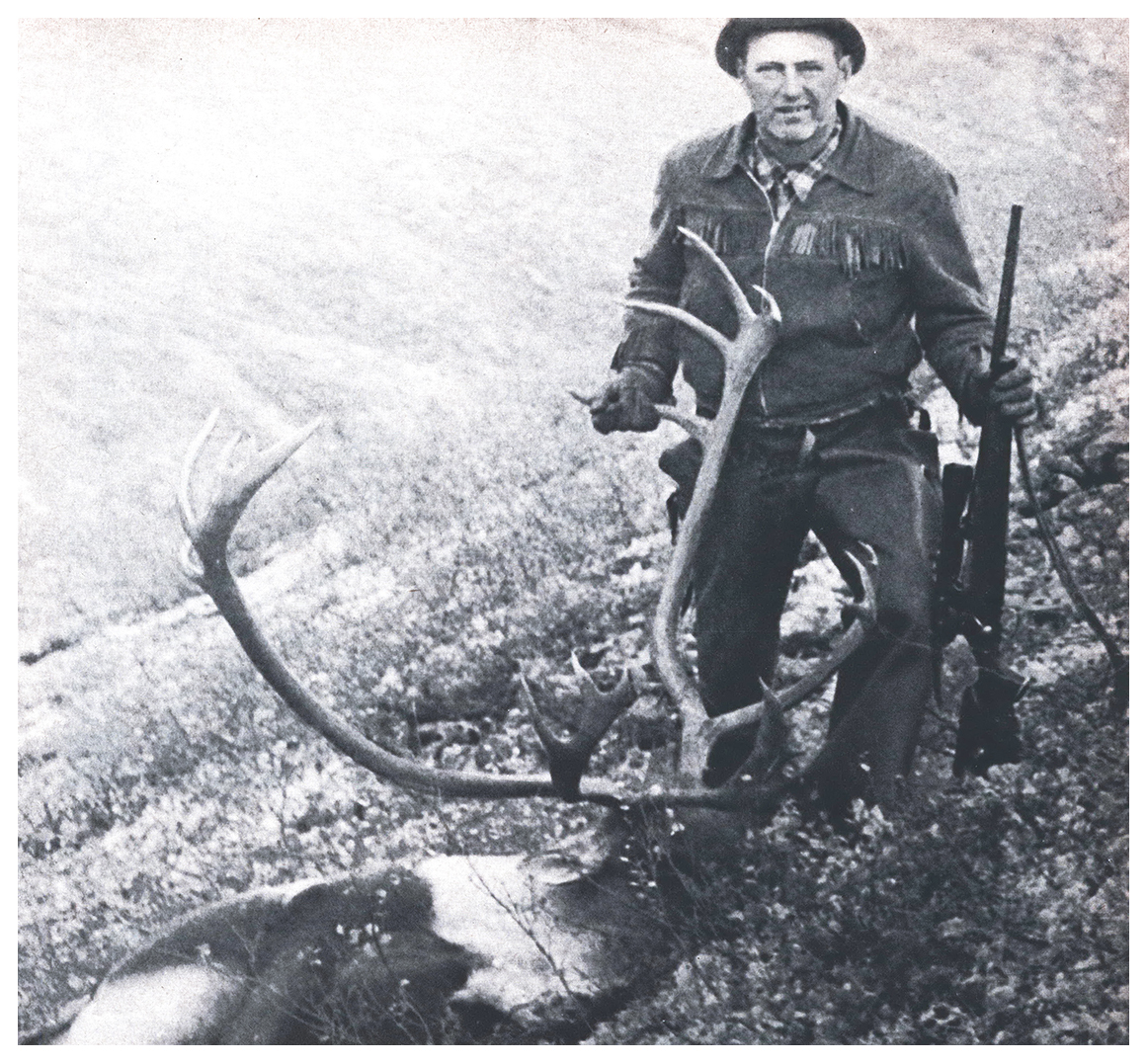
WE DRESSED OUT his bull, moved on up the valley, and ate lunch where the creek forked. Then John, Lou Brown, Paul Sloan, another of our hunting partners, and Bob Martin—Paul’s guide—rode up one valley and left the other to my guide, Paul Germain, and me. We were hardly out of sight of the spot where we’d wolfed our sandwiches when my guide reined in and waited for me.
“Let’s stop now,” he said, “to build a fire and make tea.”
“We just finished lunch,” I protested. “Let’s hunt.”
“O.K.”
We pushed through the brush another quarter of a mile, crossing the stream a couple of times and flushing a small caribou bull out of a willow clump. The animal trotted sedately out and stood on the hillside, looking back. I tried taking a picture.
“Build a fire?” my guide suggested, before I got back in the saddle. “And make tea?”
“We hunt,” I stated.
“O.K.”
We stopped to look at fresh bear sign, indicating that the animal was minutes ahead of us, and for a while I was more concerned with watching for movement in the brush ahead than in scanning the hillsides. But Paul didn’t miss a trick. Suddenly he swung out of the saddle.
“Look! On the hill!”
The grizzly had been close, all right. It was running through the blueberries along a contour of the mountain, not more than 300 yards away. Across the shoulders it wore that satiny golden saddle Lou Brown had been telling us about. With one foot on the ground, I was pulling my rifle before I spotted a small bundle of fur bouncing along at the big bear’s heels. I sheathed the gun and watched the old female and her cub out of sight.
“Let’s make tea now,” Paul said.
“Well—all right,” I said. “But let’s wait till we get to the next fork of the canyon so I can glass the slopes while you brew that infernal pot of tea.”
“O.K. I’ll make tea.”
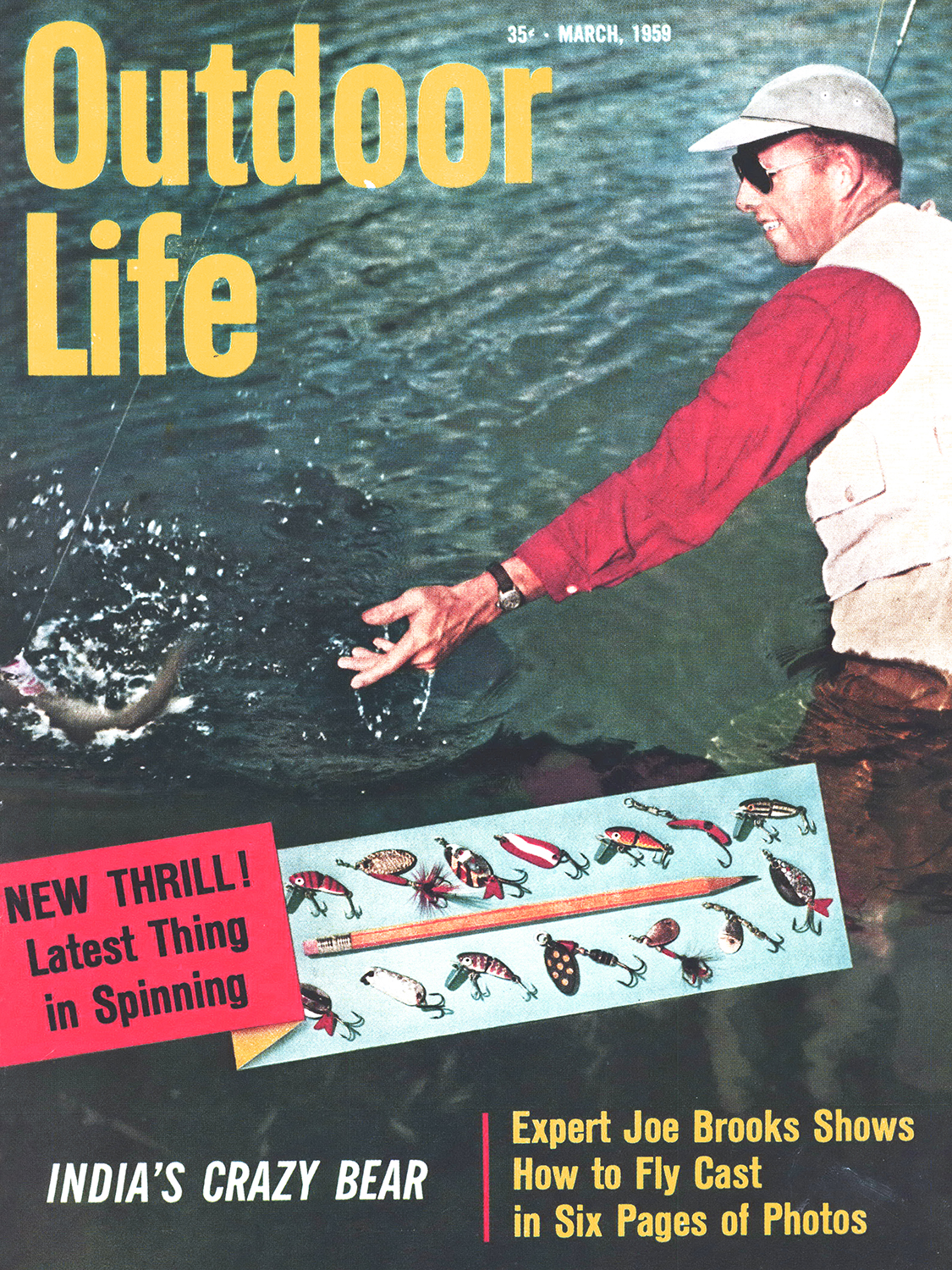
The next fork of the valley was about two miles away. I slid out of the saddle, pulled on my jacket against the chill of the wind, watching while my guide quickly made a blaze, brought water from the stream, and hung it over the flames in a sooty tin can he carried in his saddlebag. Then he returned to his saddlebag and pulled out a chunk of fresh caribou ribs he’d cut from John’s bull. For the first time I understood why he’d been so anxious to make “tea.” The luncheon sandwich hadn’t been heavy enough to stick to his insides.
For an hour, while the meat was broiling, I glassed the hillsides and tops, and walked along the creek studying the bear and wolf tracks. Then I joined Paul in the first of many such delightful rib-chewings. We sat, gnawing bones like a couple of wolves, and I’ll take an oath that caribou ribs broiled this way can spoil a man for any other type of eating
From that moment, until we moved into our last camp on the banks of the Bonnet Plume, we saw maybe 100 caribou on our hunts for sheep, moose, and bear. Most were cows and calves, or young bulls. I didn’t get a look at another rack as big as the one John took on Bourbon Creek.
IT WAS DURING the last few days of the trip, when Lou Brown, John Harness, and I were scouting for grizzlies, that we stumbled onto one of the main migration routes of the caribou herds. Trails were cut deep in the moss, showing that bands of the southbound animals had already passed. John and Lou, cutting for sign in one of the high valleys, stumbled into a herd of big antlered bulls.
“I glassed one good rack,” Lou confided to me, “with your name on it.”
When we returned to camp late that night, we learned that Bill Boone, a California rancher in our party, had ridden in only minutes before. Bill brought a big set of antlers from a caribou that he and Doc Johnny, his guide, had jumped on a mountain up river from camp. That made me even more anxious than ever to add a caribou to my trophy list.
So, with only a few days to go before the end of this dream assignment for Oudoor Life, I went with Lou Brown to find caribou. And that’s when I got off on the wrong foot by missing the caribou standing broadside at little more than 250 yards. But after getting my scope sight back into alignment, I now had this second—and perhaps final—chance.
IT’S FUNNY HOW many thoughts shoot through a guy’s head when he has only seconds to make up his mind. From the valley Lou and I had studied the big bull I was stalking. I remembered it’s rack well enough to be satisfied he wasn’t in this trio on the brow of the mountain. Whether the bull I was after had been spooked along with these three, I had no idea. The largest of the three carried a trophy at least as good, maybe a shade better, as any I’d seen. He sported a long shovel, and wide, slick, velvet-free antlers. But he was making tracks fast, and in seconds he’d be gone across the towering hill.
All those thoughts were wheeling through my head, along with the slight misgiving that persisted about the rifle’s accuracy. I clicked off the safety and swung with the running bull. He was at least 150 yards away and I didn’t dare try for a running neck shot.
I threw the crosshairs behind his shoulder, and touched off. He went down as if he’d stumbled over a barbed-wire fence, rolled a dozen yards downslope, and was jerked to a halt when his big rack jammed into the rocky ground. His two companions shifted into another gear and disappeared behind the skyline. I leaned against the canyon wall, wiping salt off my brow.
Twenty minutes later, when I panted up to where the bull lay, Lou appeared on the lower slope with our horses. He tied them at the first sharp break of the mountain, and climbed to where I sat beside the bull. That storm at the head of the canyon was blowing directly toward us. The guide pushed back his hat.
“I was watching the bull you started out to stalk,” he said, “and when I heard the shot, I thought you’d missed again.”
“Wouldn’t have surprised me any,” I admitted, “But it sure would have made that ride back to camp a lot longer than it’s gonna be.”
Lou looked at his watch: 6:15. We were at least 20 rugged mountain miles from cook Frenchy’s dining table at base camp. But even that didn’t matter.
We got busy with our knives. And with the steady zip, zip, zip of sharp steel on tissue, I got to thinking that this is one trophy that’ll sure make my muscles sag every time I look at it on the den wall.
This text has been minimally edited to meet contemporary standards.
